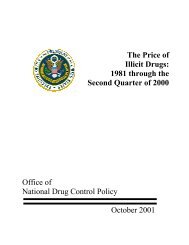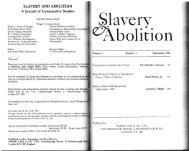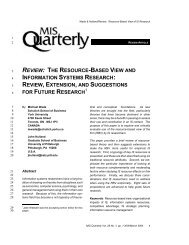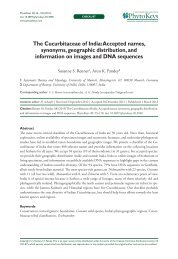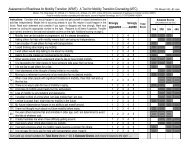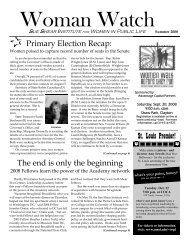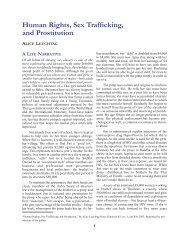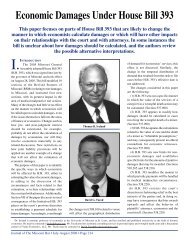an analysis of parole decision making using a sample of sex offenders
an analysis of parole decision making using a sample of sex offenders
an analysis of parole decision making using a sample of sex offenders
Create successful ePaper yourself
Turn your PDF publications into a flip-book with our unique Google optimized e-Paper software.
8 HUEBNER F.DOC 11/1/2006 8:49:12 AM<br />
PAROLE DECISION MAKING 979<br />
children. Meg<strong>an</strong>’s Law <strong>an</strong>d similar legislation has created <strong>an</strong> image <strong>of</strong> <strong>sex</strong><br />
<strong>of</strong>fenders as incorrigible (Sample <strong>an</strong>d Bray, 2003), <strong>an</strong>d this community<br />
concern appears to have permeated the <strong>parole</strong> <strong>decision</strong> process. As noted,<br />
the <strong>parole</strong> board is the sole gatekeeper between the prison <strong>an</strong>d<br />
community; therefore, the moral threat <strong>an</strong>d risk that these <strong>of</strong>fenders<br />
present appear to weigh heavily on <strong>parole</strong> <strong>decision</strong>s.<br />
Furthermore, the results reveal that <strong>parole</strong> actors consider individual<br />
demographic characteristics, net <strong>of</strong> crime seriousness. Offender age was<br />
signific<strong>an</strong>t across models, with older men less likely to be <strong>parole</strong>d. In<br />
contrast to traditional violence <strong>an</strong>d judicial <strong>decision</strong> <strong>making</strong> research,<br />
older men who have committed <strong>sex</strong> crimes appear to be viewed as a<br />
greater risk to the community th<strong>an</strong> younger men. Even though the effect<br />
<strong>of</strong> age is small, the stability <strong>of</strong> the finding signals a unique bias for <strong>sex</strong><br />
<strong>of</strong>fenders.<br />
The relationship between race <strong>an</strong>d <strong>parole</strong> outcomes is more complex.<br />
In initial models, minorities were signific<strong>an</strong>tly less likely to be <strong>parole</strong>d;<br />
however, the race-ethnicity effect disappeared when the community<br />
protection <strong>an</strong>d <strong>parole</strong> readiness measures were included. The failure to<br />
detect a race effect is surprising given prior research (Bridges <strong>an</strong>d<br />
Crutchfield, 1988; Steffensmeier <strong>an</strong>d Demuth, 2000, 2001; Ulmer <strong>an</strong>d<br />
Johnson, 2004), which suggests that <strong>decision</strong> makers perceive minority<br />
males as unique threats to the community. The null finding may be due in<br />
part to the composition <strong>of</strong> the study <strong>sample</strong> <strong>an</strong>d to the coding <strong>of</strong> race,<br />
which merges Hisp<strong>an</strong>ics, blacks, <strong>an</strong>d other ethnicities <strong>an</strong>d races into a<br />
single category. Parole board members consider race <strong>an</strong>d ethnicity when<br />
<strong>making</strong> <strong>decision</strong>s, but assessments <strong>of</strong> community protection, particularly<br />
as it relates to institutional misconduct <strong>an</strong>d victim age, appear to<br />
supersede race-ethnicity. In addition, when compared to other <strong>of</strong>fense<br />
classifications (for example, robbery), <strong>sex</strong> <strong>of</strong>fenders are predominately<br />
white, thus minority males may not represent as much <strong>of</strong> a threat.<br />
However, the role <strong>of</strong> race-ethnicity in previous research has been so<br />
prominent that it is import<strong>an</strong>t to consider the role <strong>of</strong> race <strong>an</strong>d ethnicity in<br />
future research on <strong>parole</strong> <strong>decision</strong> <strong>making</strong>.<br />
Although our study makes adv<strong>an</strong>ces over prior <strong>parole</strong> <strong>decision</strong> <strong>making</strong><br />
research, several caveats are in order. First, the study as designed does not<br />
include implicit measures <strong>of</strong> the third focal concern, org<strong>an</strong>izational<br />
constraints <strong>an</strong>d practical consequences. The results do confirm the<br />
conclusions <strong>of</strong> past research (Carrol <strong>an</strong>d Burke, 1990), which suggest that<br />
<strong>parole</strong> board members in states with indeterminate sentencing schemes<br />
will be more likely to consider factors outside the legal definition <strong>of</strong> the<br />
<strong>of</strong>fense. That noted, little else is known about the context <strong>of</strong> <strong>parole</strong><br />
<strong>decision</strong>s. Future research, particularly as it relates to the effect <strong>of</strong> crossstate<br />
differences in prison capacity, sentencing structure, <strong>an</strong>d political




